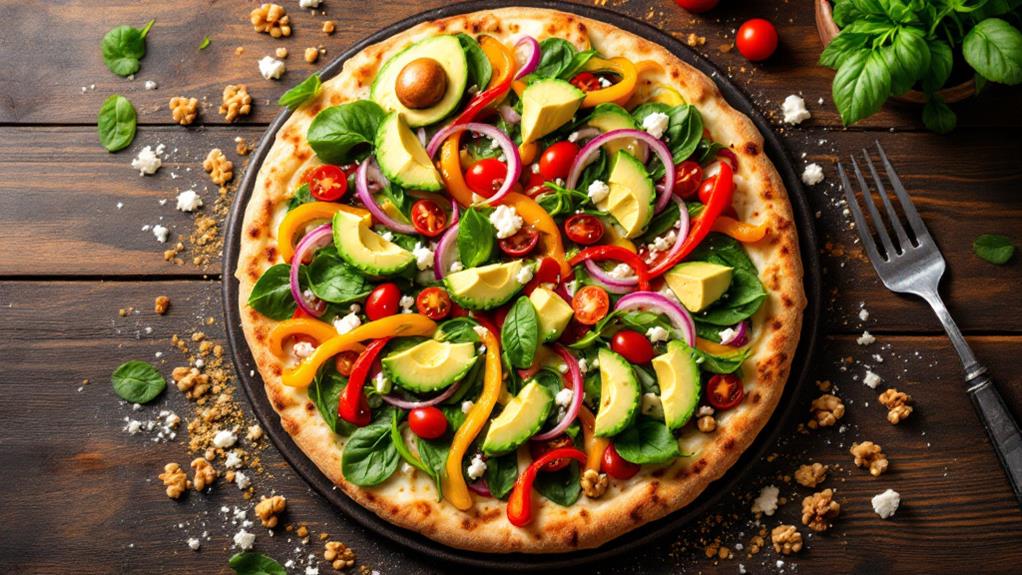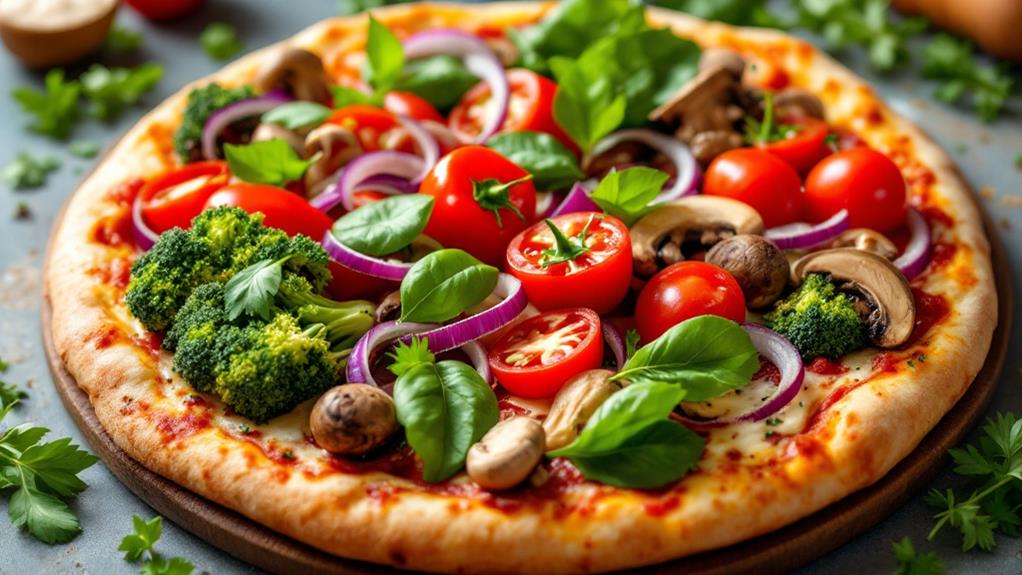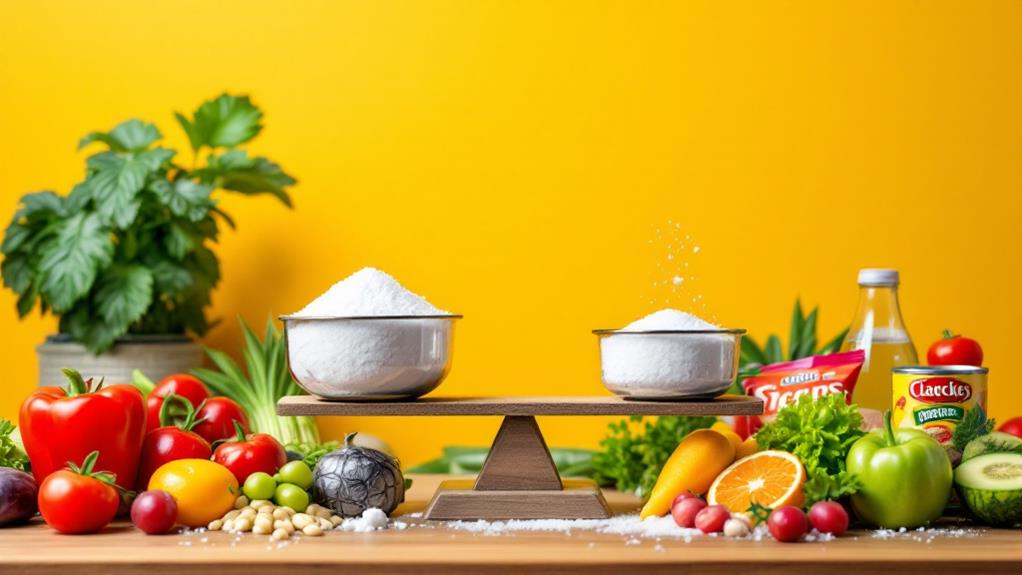Healthy Toppings You Can Add to Pizza for a Nutritious Twist

Revamp your pizza with nutritious toppings for a delicious twist. Start by choosing a whole wheat or cauliflower crust to increase fiber and lower carbs. Top with lean proteins like grilled chicken or plant-based options such as chickpeas for added protein and fiber. Pile on lively veggies like spinach, bell peppers, and tomatoes to improve vitamins and minerals. Opt for part-skim mozzarella or vegan cheese to cut down on fat while keeping creamy textures. Don't forget flavor-enhancing herbs like basil and oregano for aroma and antioxidants. Try new sauce options like pesto or Greek yogurt for a healthful upgrade. Investigate further to uncover more creative ideas.
Choosing a Nutritious Base
When it comes to making a healthy pizza, selecting a nutritious base is crucial. Opting for a whole wheat crust can greatly improve your homemade pizza's nutritional value by adding fiber and important nutrients. This choice results in a thin crust that's both crunchy and satisfying. For even more variety in your veggie pizza, consider alternative crust options like cauliflower, sweet potato, or zucchini. These alternatives are perfect if you're cutting down on carbohydrates or following a gluten-free diet, as they offer nutrient-dense profiles.
When crafting your pizza dough from scratch, you gain control over the ingredients, ensuring your crust is free from preservatives and unnecessary additives. Homemade options, such as almond flour or quinoa crusts, allow you to customize your pizza to meet personal dietary needs while maximizing its health benefits. A thin crust not only lowers calorie intake per slice but also contributes to a delightful crunch, making your healthy pizza experience even more enjoyable.
Pair your nutritious base with a lively pizza sauce and a generous topping of fresh vegetables, and you've created a wholesome veggie pizza that stands out for both flavor and health.
Lean Protein Options
Adding lean protein options to your pizza not only increases its nutritional value but also improves its flavor profile. Grilled chicken and turkey sausage are excellent choices that can greatly reduce calorie and fat content while still providing vital amino acids for muscle repair and growth. A 3-ounce serving of grilled chicken, for example, offers approximately 26 grams of protein, perfect for elevating your intake.
Incorporating plant-based proteins like chickpeas or black beans can also enrich your pizza. These options add fiber, making your meal more filling and satisfying. They're great if you're looking to diversify your protein sources while keeping things healthy and delicious.
Seafood toppings, such as shrimp and salmon, provide another nutritious twist. These options are rich in omega-3 fatty acids, promoting heart health and reducing inflammation. They add a unique flavor to your pizza that's both light and invigorating.
Lastly, consider limiting processed meats like pepperoni and sausage, which are often high in sodium and unhealthy fats. Opt instead for leaner alternatives, like chicken breast or turkey pepperoni. These choices contribute to a healthier pizza, supporting your comprehensive wellness goals.
Vibrant Vegetable Toppings

While lean proteins improve the nutritional value of your pizza, don't overlook the power of colorful vegetable toppings to elevate your creation. Adding fresh vegetables like spinach, bell peppers, and tomatoes not only amplifies flavor but also improves the vitamin and mineral content, providing crucial nutrients for your comprehensive health. These healthy enhancements transform your pizza into a nutrient-rich meal.
Incorporate dark leafy greens like kale or arugula to increase fiber content, promoting better digestion and keeping you full longer. These greens are excellent vegetable toppings that make your pizza both tasty and satisfying. Don't forget about seasonal produce like zucchini or eggplant; they not only offer unique flavors and textures but are also cost-effective and environmentally friendly choices.
Roasted vegetables like mushrooms and bell peppers add depth and richness, along with antioxidants that help combat inflammation. By using a variety of colorful vegetables, you not only make your pizza visually appealing but also elevate its antioxidant levels, potentially protecting against chronic diseases. Welcome these lively vegetable toppings to create a pizza that's not just healthy but also a feast for the senses.
Cheese and Dairy Alternatives
When crafting a healthier pizza, consider swapping traditional cheese with more nutritious alternatives. Part-skim mozzarella is a fantastic option, offering fewer calories and less fat than regular mozzarella. This makes it a healthier choice without sacrificing that beloved cheesy flavor. If you're looking to go dairy-free, investigate vegan cheese options made from nuts or soy. These options provide a creamy texture and delightful flavor similar to conventional cheese, ensuring you don't miss out on any of the indulgence.
Lower-fat Parmesan is another excellent choice. It improves your pizza's taste without burdening it with excessive saturated fat. You can enjoy a flavorful slice while keeping your meal healthy. Another unique option is nutritional yeast. This dairy-free topping not only delivers a cheesy flavor but is also rich in B vitamins and protein, making it an ideal supplement for vegans and anyone seeking extra nutrients.
To further cut down on calorie intake, balance your cheese with plenty of vegetable toppings. This approach not only raises the nutritional value of your pizza but also lets you enjoy a delicious meal that's both satisfying and guilt-free.
Flavor Boosting Herbs

Once you've mastered the art of selecting healthier cheese options, it's time to explore how herbs can transform your pizza into a flavor-packed, nutrient-rich delight. Fresh herbs not only heighten the taste but also infuse your meal with vital nutrients and antioxidants. Let's delve into some flavorful choices:
- Basil, Oregano, and Thyme: These classic herbs are a must-have for any pizza lover. Basil and oregano provide a robust aroma and a health improvement with their antioxidants. Thyme adds a subtle earthiness and complements the other flavors beautifully.
- Parsley and Rosemary: Fresh parsley is an excellent source of vitamin K, essential for bone health and blood clotting. Rosemary, with its anti-inflammatory and digestion-friendly properties, brings a fragrant, pine-like taste to your pizza.
- Garlic, Arugula, and Cilantro: Garlic offers a bold flavor and antimicrobial benefits that can enhance your immune system. For a peppery twist, add arugula to your pizza. Cilantro introduces a fresh, citrusy note and packs supplementary vitamins and minerals.
Experimenting with these fresh herbs can make your pizza not only tastier but also a healthier option. Try them and enjoy a new dimension of flavor!
Creative Sauce Options
Exploring creative sauce options can improve your pizza from ordinary to extraordinary. To make healthy pizzas, start by rethinking the traditional tomato sauce. Homemade versions using crushed tomatoes, garlic, and fresh herbs allow you to control added sugars and sodium, ensuring a wholesome base. For a nutritious twist, consider using pesto. Made from basil, olive oil, and nuts, pesto offers a flavorful alternative that's packed with healthy fats and antioxidants.
If you're looking for something lighter, try using olive oil as a base. Infuse it with garlic and herbs to create a sauce that boosts flavor without the extra calories found in cream-based sauces. This simple swap keeps your pizza light while delivering whole, fresh flavors.
For a protein-rich option, blend Greek yogurt with herbs and spices to craft a creamy sauce. This inventive choice pairs well with a variety of toppings, adding a unique texture and taste.
Don't hesitate to experiment with unique sauces like barbecue or buffalo sauce. These can add a delicious twist and introduce exciting flavor profiles to your pizza. Welcome these creative sauce options to transform your pizza into a nutritious masterpiece.
Healthy Cooking Techniques

To make your pizza healthier, focus on cooking techniques that improve flavor and texture without adding unnecessary calories. Start by preheating the oven to 450°F. This guarantees even cooking and results in a crispy crust, enhancing your pizza's complete texture. Consider using a baking sheet with parchment paper to prevent sticking and facilitate easy cleanup. Alternatively, a pizza stone can absorb moisture and distribute heat evenly, helping you achieve a crust that is golden brown.
For a nutritious twist, you might want to investigate these options:
- Grill your pizza: Grilling at high temperatures adds a smoky flavor and unique texture, making it an exciting alternative to traditional baking.
- Monitor baking times: Keep a close eye on your pizza, typically baking for 10-15 minutes, to avoid overcooking and achieve that perfect golden-brown finish.
- Experiment with toppings: After the crust is ready, add your sauce and consider topping with roasted cauliflower for added nutrients and flavor.
These healthy cooking techniques transform pizza into a delightful comfort food without sacrificing health. By incorporating these methods, you'll enjoy a delicious meal that's both satisfying and nutritious.




